Contemporary Hospitality Industry Report - Business Analysis
VerifiedAdded on 2020/10/05
|10
|2789
|216
Report
AI Summary
This report provides a comprehensive analysis of the contemporary hospitality industry, focusing on its scope, scale, and diversity. The report examines the current scale of the industry, including the number of businesses and their impact on the UK economy, and explores the diversity of products and services offered. It further delves into the organizational structures of different hospitality organizations, such as hotels and restaurants, highlighting hierarchical and functional structures. The report also evaluates staffing needs, including the duties, responsibilities, and qualifications required for various hospitality roles, using examples like Duck and Waffle in London. The report covers the functions of hospitality organizations and professional firms, such as the British Hospitality Association, and concludes with a summary of the key findings.
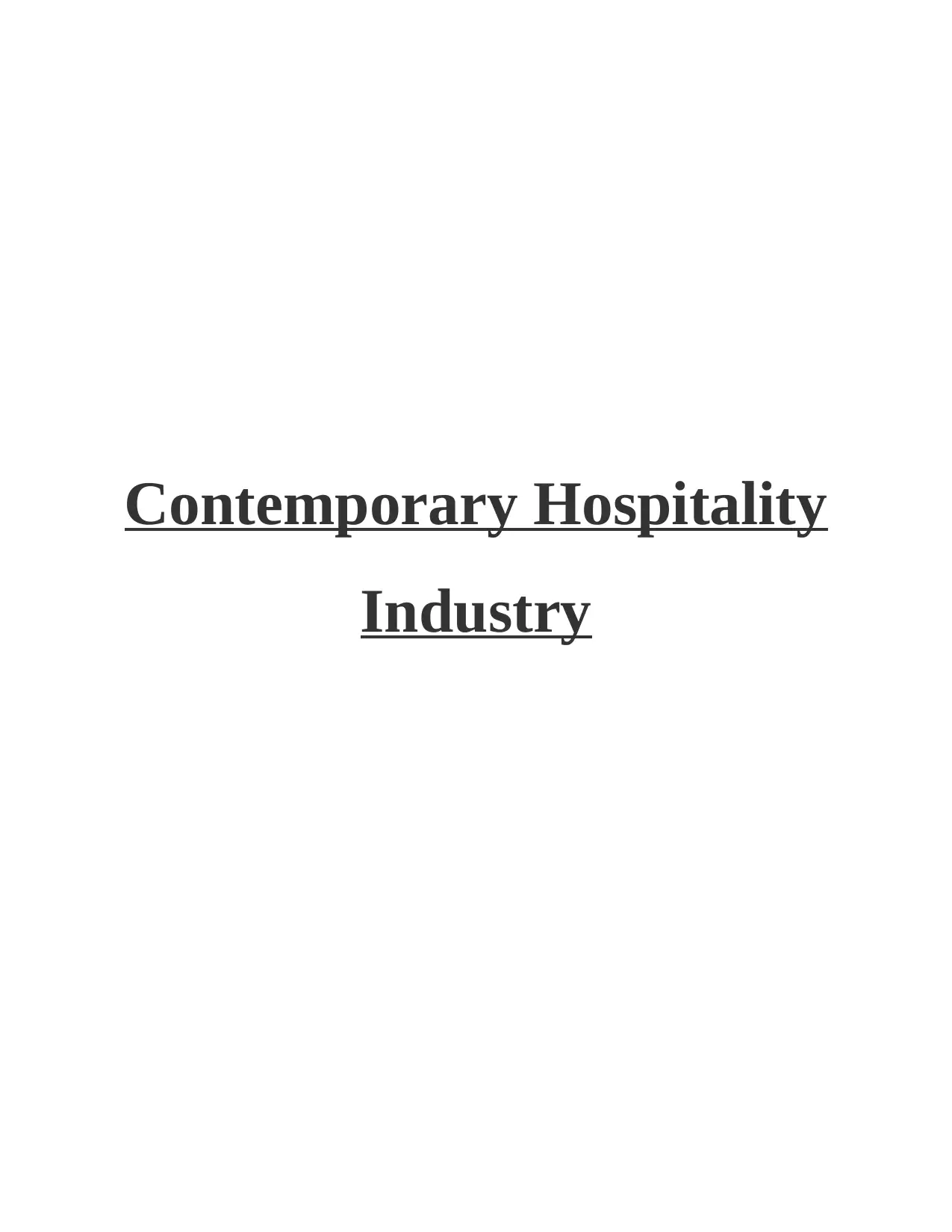
Contemporary Hospitality
Industry
Industry
Paraphrase This Document
Need a fresh take? Get an instant paraphrase of this document with our AI Paraphraser
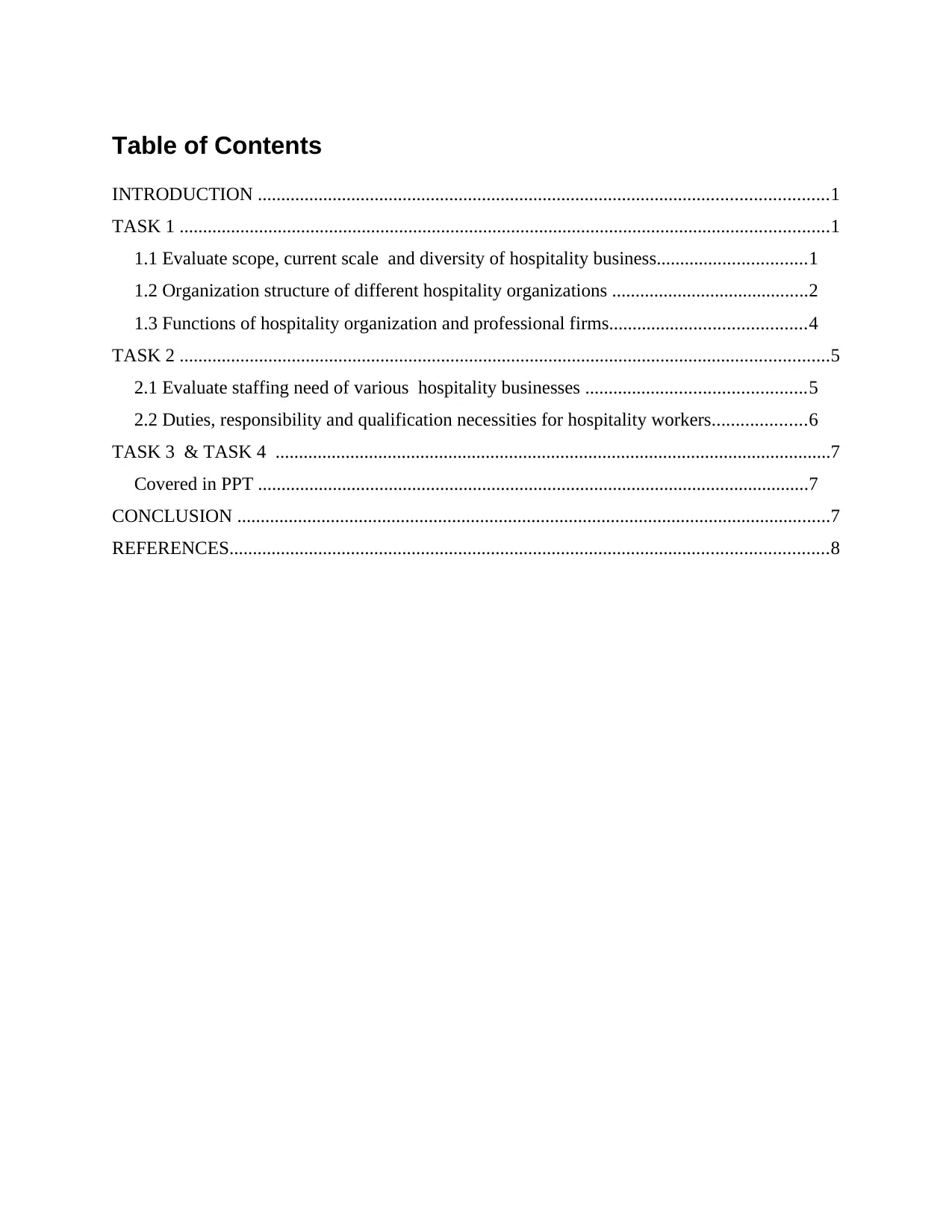
Table of Contents
INTRODUCTION ..........................................................................................................................1
TASK 1 ...........................................................................................................................................1
1.1 Evaluate scope, current scale and diversity of hospitality business................................1
1.2 Organization structure of different hospitality organizations ..........................................2
1.3 Functions of hospitality organization and professional firms..........................................4
TASK 2 ...........................................................................................................................................5
2.1 Evaluate staffing need of various hospitality businesses ...............................................5
2.2 Duties, responsibility and qualification necessities for hospitality workers....................6
TASK 3 & TASK 4 .......................................................................................................................7
Covered in PPT ......................................................................................................................7
CONCLUSION ...............................................................................................................................7
REFERENCES................................................................................................................................8
INTRODUCTION ..........................................................................................................................1
TASK 1 ...........................................................................................................................................1
1.1 Evaluate scope, current scale and diversity of hospitality business................................1
1.2 Organization structure of different hospitality organizations ..........................................2
1.3 Functions of hospitality organization and professional firms..........................................4
TASK 2 ...........................................................................................................................................5
2.1 Evaluate staffing need of various hospitality businesses ...............................................5
2.2 Duties, responsibility and qualification necessities for hospitality workers....................6
TASK 3 & TASK 4 .......................................................................................................................7
Covered in PPT ......................................................................................................................7
CONCLUSION ...............................................................................................................................7
REFERENCES................................................................................................................................8
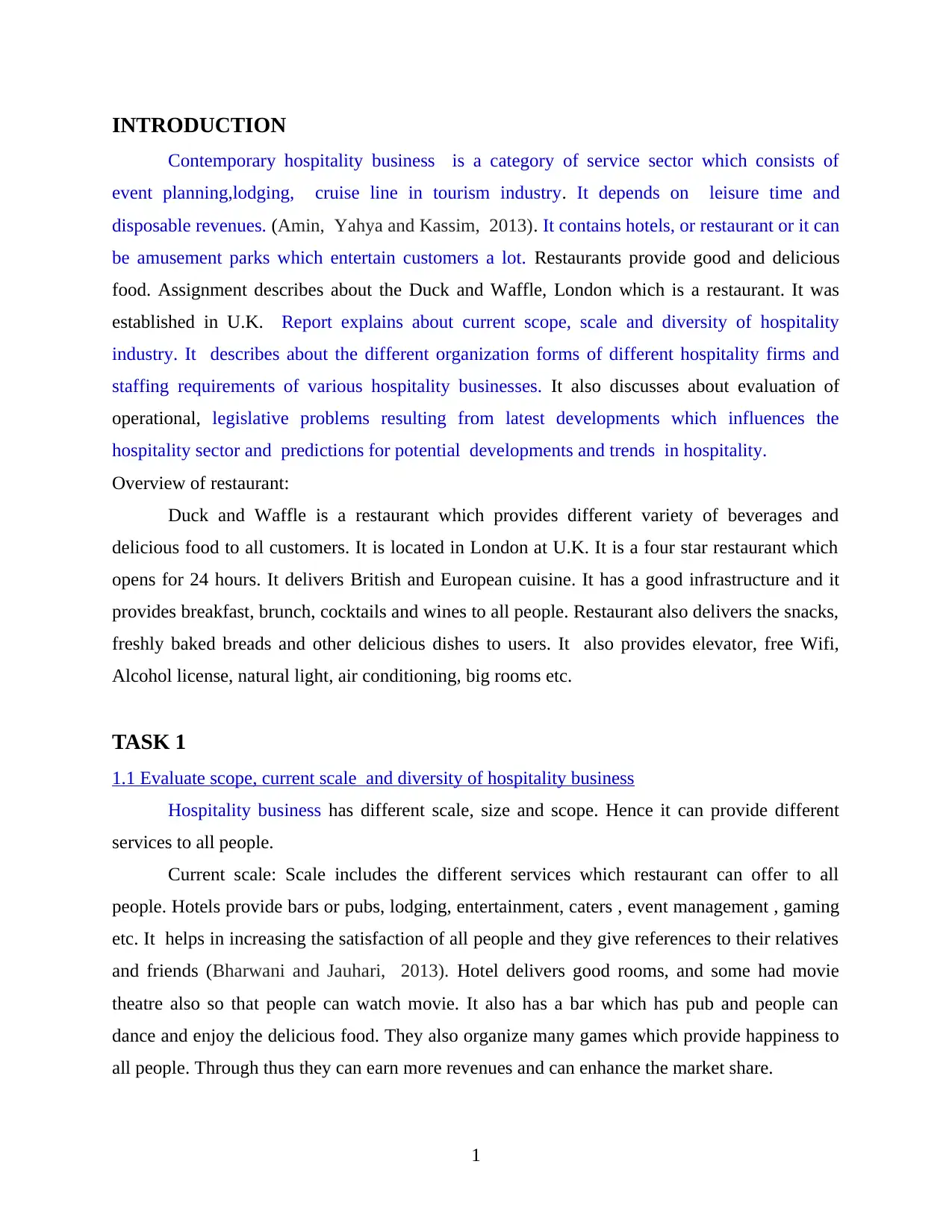
INTRODUCTION
Contemporary hospitality business is a category of service sector which consists of
event planning,lodging, cruise line in tourism industry. It depends on leisure time and
disposable revenues. (Amin, Yahya and Kassim, 2013). It contains hotels, or restaurant or it can
be amusement parks which entertain customers a lot. Restaurants provide good and delicious
food. Assignment describes about the Duck and Waffle, London which is a restaurant. It was
established in U.K. Report explains about current scope, scale and diversity of hospitality
industry. It describes about the different organization forms of different hospitality firms and
staffing requirements of various hospitality businesses. It also discusses about evaluation of
operational, legislative problems resulting from latest developments which influences the
hospitality sector and predictions for potential developments and trends in hospitality.
Overview of restaurant:
Duck and Waffle is a restaurant which provides different variety of beverages and
delicious food to all customers. It is located in London at U.K. It is a four star restaurant which
opens for 24 hours. It delivers British and European cuisine. It has a good infrastructure and it
provides breakfast, brunch, cocktails and wines to all people. Restaurant also delivers the snacks,
freshly baked breads and other delicious dishes to users. It also provides elevator, free Wifi,
Alcohol license, natural light, air conditioning, big rooms etc.
TASK 1
1.1 Evaluate scope, current scale and diversity of hospitality business
Hospitality business has different scale, size and scope. Hence it can provide different
services to all people.
Current scale: Scale includes the different services which restaurant can offer to all
people. Hotels provide bars or pubs, lodging, entertainment, caters , event management , gaming
etc. It helps in increasing the satisfaction of all people and they give references to their relatives
and friends (Bharwani and Jauhari, 2013). Hotel delivers good rooms, and some had movie
theatre also so that people can watch movie. It also has a bar which has pub and people can
dance and enjoy the delicious food. They also organize many games which provide happiness to
all people. Through thus they can earn more revenues and can enhance the market share.
1
Contemporary hospitality business is a category of service sector which consists of
event planning,lodging, cruise line in tourism industry. It depends on leisure time and
disposable revenues. (Amin, Yahya and Kassim, 2013). It contains hotels, or restaurant or it can
be amusement parks which entertain customers a lot. Restaurants provide good and delicious
food. Assignment describes about the Duck and Waffle, London which is a restaurant. It was
established in U.K. Report explains about current scope, scale and diversity of hospitality
industry. It describes about the different organization forms of different hospitality firms and
staffing requirements of various hospitality businesses. It also discusses about evaluation of
operational, legislative problems resulting from latest developments which influences the
hospitality sector and predictions for potential developments and trends in hospitality.
Overview of restaurant:
Duck and Waffle is a restaurant which provides different variety of beverages and
delicious food to all customers. It is located in London at U.K. It is a four star restaurant which
opens for 24 hours. It delivers British and European cuisine. It has a good infrastructure and it
provides breakfast, brunch, cocktails and wines to all people. Restaurant also delivers the snacks,
freshly baked breads and other delicious dishes to users. It also provides elevator, free Wifi,
Alcohol license, natural light, air conditioning, big rooms etc.
TASK 1
1.1 Evaluate scope, current scale and diversity of hospitality business
Hospitality business has different scale, size and scope. Hence it can provide different
services to all people.
Current scale: Scale includes the different services which restaurant can offer to all
people. Hotels provide bars or pubs, lodging, entertainment, caters , event management , gaming
etc. It helps in increasing the satisfaction of all people and they give references to their relatives
and friends (Bharwani and Jauhari, 2013). Hotel delivers good rooms, and some had movie
theatre also so that people can watch movie. It also has a bar which has pub and people can
dance and enjoy the delicious food. They also organize many games which provide happiness to
all people. Through thus they can earn more revenues and can enhance the market share.
1
⊘ This is a preview!⊘
Do you want full access?
Subscribe today to unlock all pages.

Trusted by 1+ million students worldwide
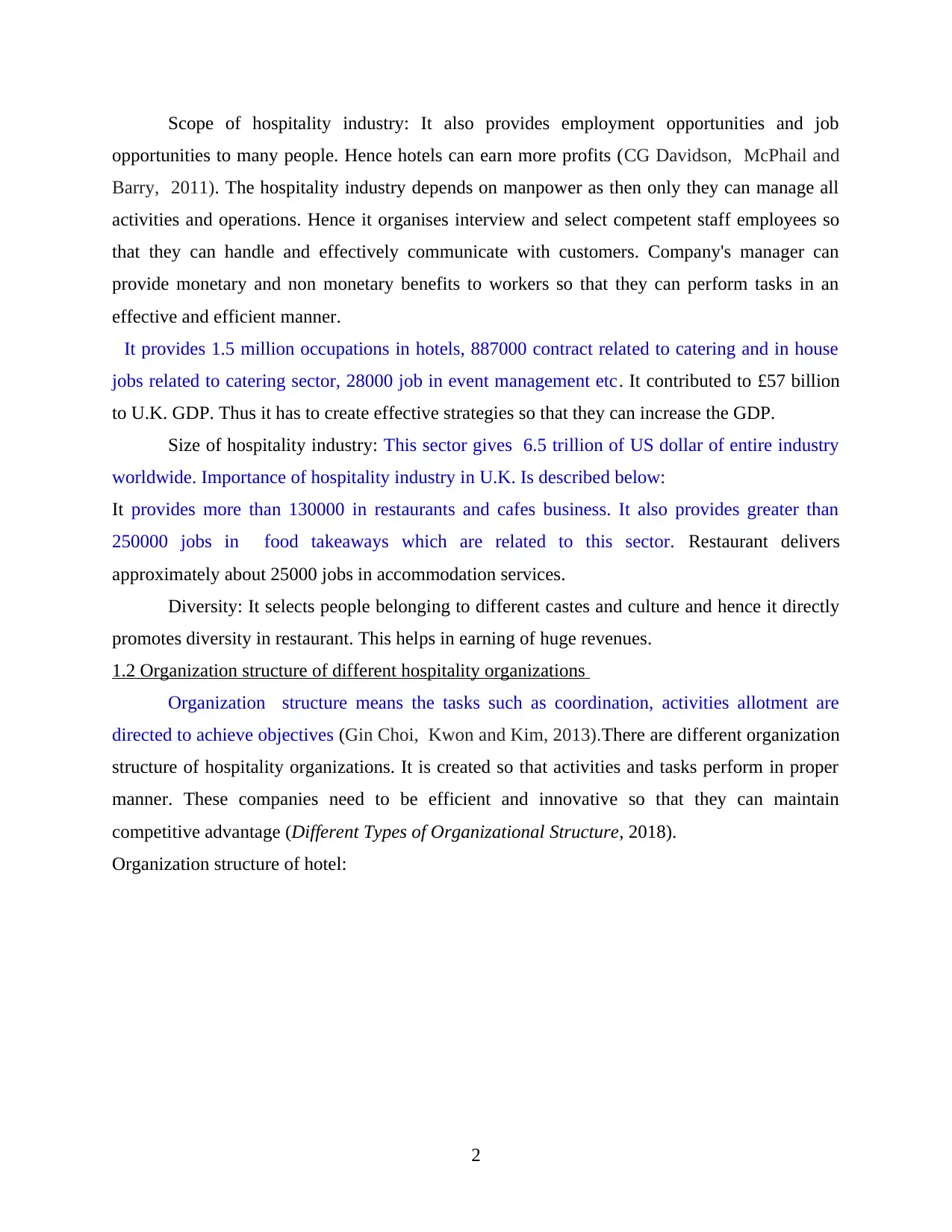
Scope of hospitality industry: It also provides employment opportunities and job
opportunities to many people. Hence hotels can earn more profits (CG Davidson, McPhail and
Barry, 2011). The hospitality industry depends on manpower as then only they can manage all
activities and operations. Hence it organises interview and select competent staff employees so
that they can handle and effectively communicate with customers. Company's manager can
provide monetary and non monetary benefits to workers so that they can perform tasks in an
effective and efficient manner.
It provides 1.5 million occupations in hotels, 887000 contract related to catering and in house
jobs related to catering sector, 28000 job in event management etc. It contributed to £57 billion
to U.K. GDP. Thus it has to create effective strategies so that they can increase the GDP.
Size of hospitality industry: This sector gives 6.5 trillion of US dollar of entire industry
worldwide. Importance of hospitality industry in U.K. Is described below:
It provides more than 130000 in restaurants and cafes business. It also provides greater than
250000 jobs in food takeaways which are related to this sector. Restaurant delivers
approximately about 25000 jobs in accommodation services.
Diversity: It selects people belonging to different castes and culture and hence it directly
promotes diversity in restaurant. This helps in earning of huge revenues.
1.2 Organization structure of different hospitality organizations
Organization structure means the tasks such as coordination, activities allotment are
directed to achieve objectives (Gin Choi, Kwon and Kim, 2013).There are different organization
structure of hospitality organizations. It is created so that activities and tasks perform in proper
manner. These companies need to be efficient and innovative so that they can maintain
competitive advantage (Different Types of Organizational Structure, 2018).
Organization structure of hotel:
2
opportunities to many people. Hence hotels can earn more profits (CG Davidson, McPhail and
Barry, 2011). The hospitality industry depends on manpower as then only they can manage all
activities and operations. Hence it organises interview and select competent staff employees so
that they can handle and effectively communicate with customers. Company's manager can
provide monetary and non monetary benefits to workers so that they can perform tasks in an
effective and efficient manner.
It provides 1.5 million occupations in hotels, 887000 contract related to catering and in house
jobs related to catering sector, 28000 job in event management etc. It contributed to £57 billion
to U.K. GDP. Thus it has to create effective strategies so that they can increase the GDP.
Size of hospitality industry: This sector gives 6.5 trillion of US dollar of entire industry
worldwide. Importance of hospitality industry in U.K. Is described below:
It provides more than 130000 in restaurants and cafes business. It also provides greater than
250000 jobs in food takeaways which are related to this sector. Restaurant delivers
approximately about 25000 jobs in accommodation services.
Diversity: It selects people belonging to different castes and culture and hence it directly
promotes diversity in restaurant. This helps in earning of huge revenues.
1.2 Organization structure of different hospitality organizations
Organization structure means the tasks such as coordination, activities allotment are
directed to achieve objectives (Gin Choi, Kwon and Kim, 2013).There are different organization
structure of hospitality organizations. It is created so that activities and tasks perform in proper
manner. These companies need to be efficient and innovative so that they can maintain
competitive advantage (Different Types of Organizational Structure, 2018).
Organization structure of hotel:
2
Paraphrase This Document
Need a fresh take? Get an instant paraphrase of this document with our AI Paraphraser
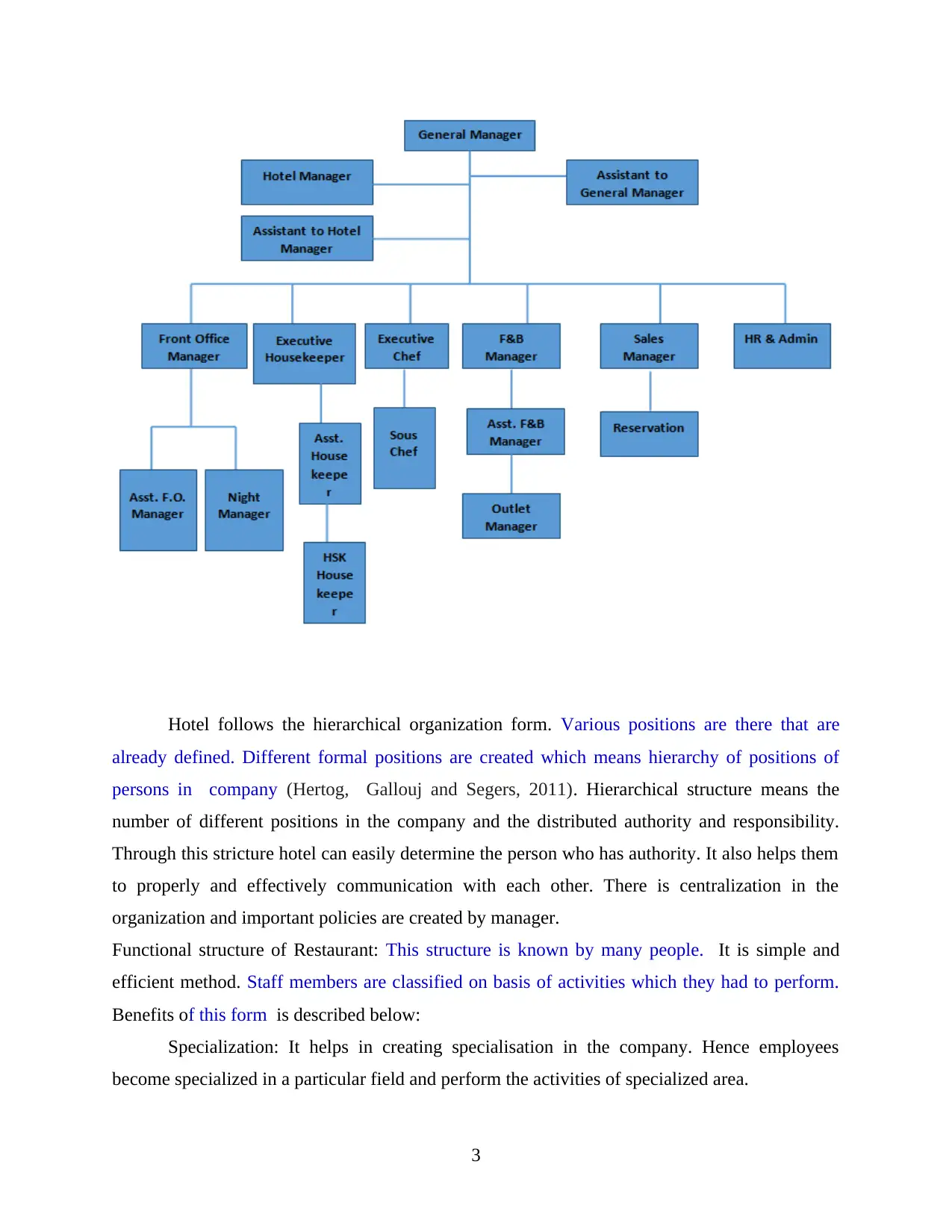
Hotel follows the hierarchical organization form. Various positions are there that are
already defined. Different formal positions are created which means hierarchy of positions of
persons in company (Hertog, Gallouj and Segers, 2011). Hierarchical structure means the
number of different positions in the company and the distributed authority and responsibility.
Through this stricture hotel can easily determine the person who has authority. It also helps them
to properly and effectively communication with each other. There is centralization in the
organization and important policies are created by manager.
Functional structure of Restaurant: This structure is known by many people. It is simple and
efficient method. Staff members are classified on basis of activities which they had to perform.
Benefits of this form is described below:
Specialization: It helps in creating specialisation in the company. Hence employees
become specialized in a particular field and perform the activities of specialized area.
3
already defined. Different formal positions are created which means hierarchy of positions of
persons in company (Hertog, Gallouj and Segers, 2011). Hierarchical structure means the
number of different positions in the company and the distributed authority and responsibility.
Through this stricture hotel can easily determine the person who has authority. It also helps them
to properly and effectively communication with each other. There is centralization in the
organization and important policies are created by manager.
Functional structure of Restaurant: This structure is known by many people. It is simple and
efficient method. Staff members are classified on basis of activities which they had to perform.
Benefits of this form is described below:
Specialization: It helps in creating specialisation in the company. Hence employees
become specialized in a particular field and perform the activities of specialized area.
3
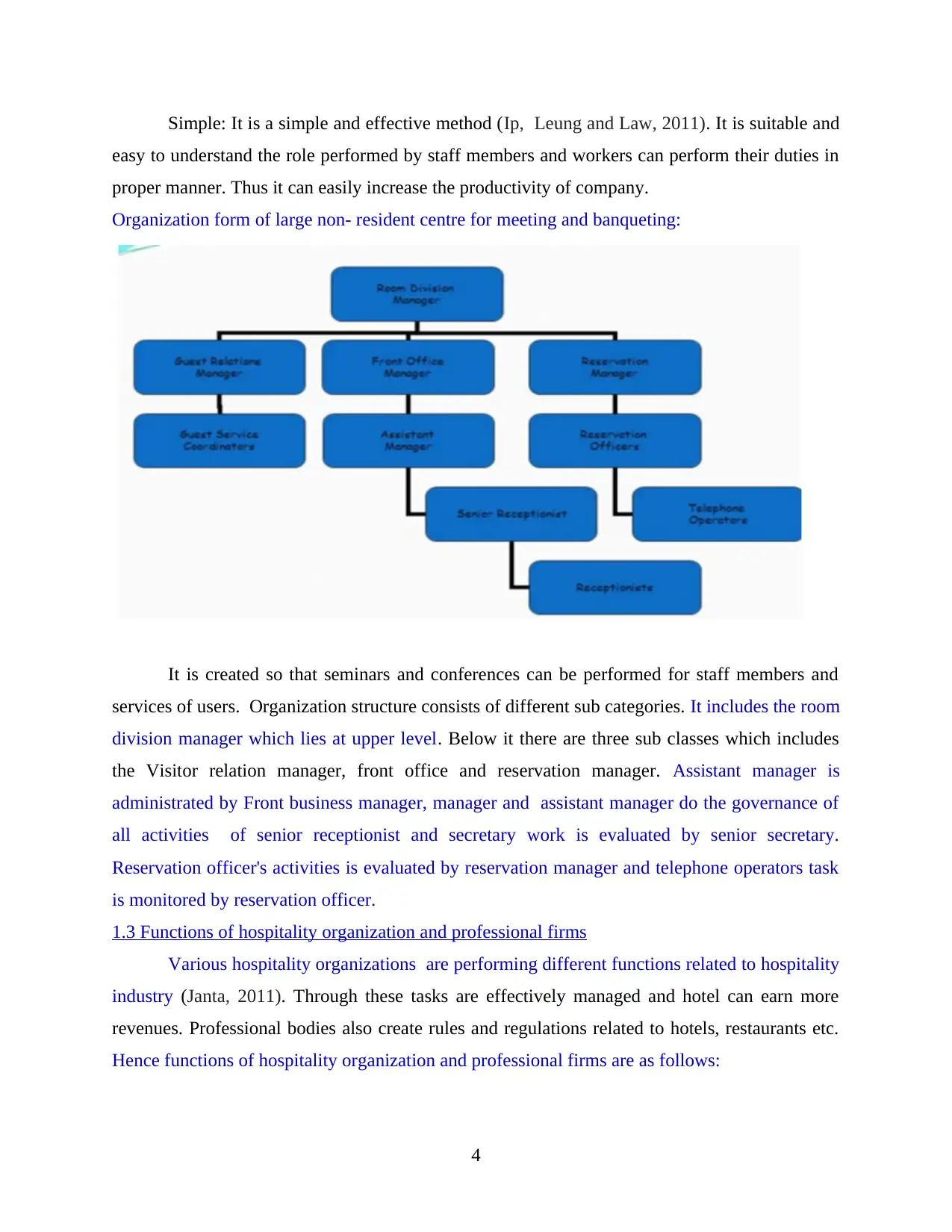
Simple: It is a simple and effective method (Ip, Leung and Law, 2011). It is suitable and
easy to understand the role performed by staff members and workers can perform their duties in
proper manner. Thus it can easily increase the productivity of company.
Organization form of large non- resident centre for meeting and banqueting:
It is created so that seminars and conferences can be performed for staff members and
services of users. Organization structure consists of different sub categories. It includes the room
division manager which lies at upper level. Below it there are three sub classes which includes
the Visitor relation manager, front office and reservation manager. Assistant manager is
administrated by Front business manager, manager and assistant manager do the governance of
all activities of senior receptionist and secretary work is evaluated by senior secretary.
Reservation officer's activities is evaluated by reservation manager and telephone operators task
is monitored by reservation officer.
1.3 Functions of hospitality organization and professional firms
Various hospitality organizations are performing different functions related to hospitality
industry (Janta, 2011). Through these tasks are effectively managed and hotel can earn more
revenues. Professional bodies also create rules and regulations related to hotels, restaurants etc.
Hence functions of hospitality organization and professional firms are as follows:
4
easy to understand the role performed by staff members and workers can perform their duties in
proper manner. Thus it can easily increase the productivity of company.
Organization form of large non- resident centre for meeting and banqueting:
It is created so that seminars and conferences can be performed for staff members and
services of users. Organization structure consists of different sub categories. It includes the room
division manager which lies at upper level. Below it there are three sub classes which includes
the Visitor relation manager, front office and reservation manager. Assistant manager is
administrated by Front business manager, manager and assistant manager do the governance of
all activities of senior receptionist and secretary work is evaluated by senior secretary.
Reservation officer's activities is evaluated by reservation manager and telephone operators task
is monitored by reservation officer.
1.3 Functions of hospitality organization and professional firms
Various hospitality organizations are performing different functions related to hospitality
industry (Janta, 2011). Through these tasks are effectively managed and hotel can earn more
revenues. Professional bodies also create rules and regulations related to hotels, restaurants etc.
Hence functions of hospitality organization and professional firms are as follows:
4
⊘ This is a preview!⊘
Do you want full access?
Subscribe today to unlock all pages.

Trusted by 1+ million students worldwide
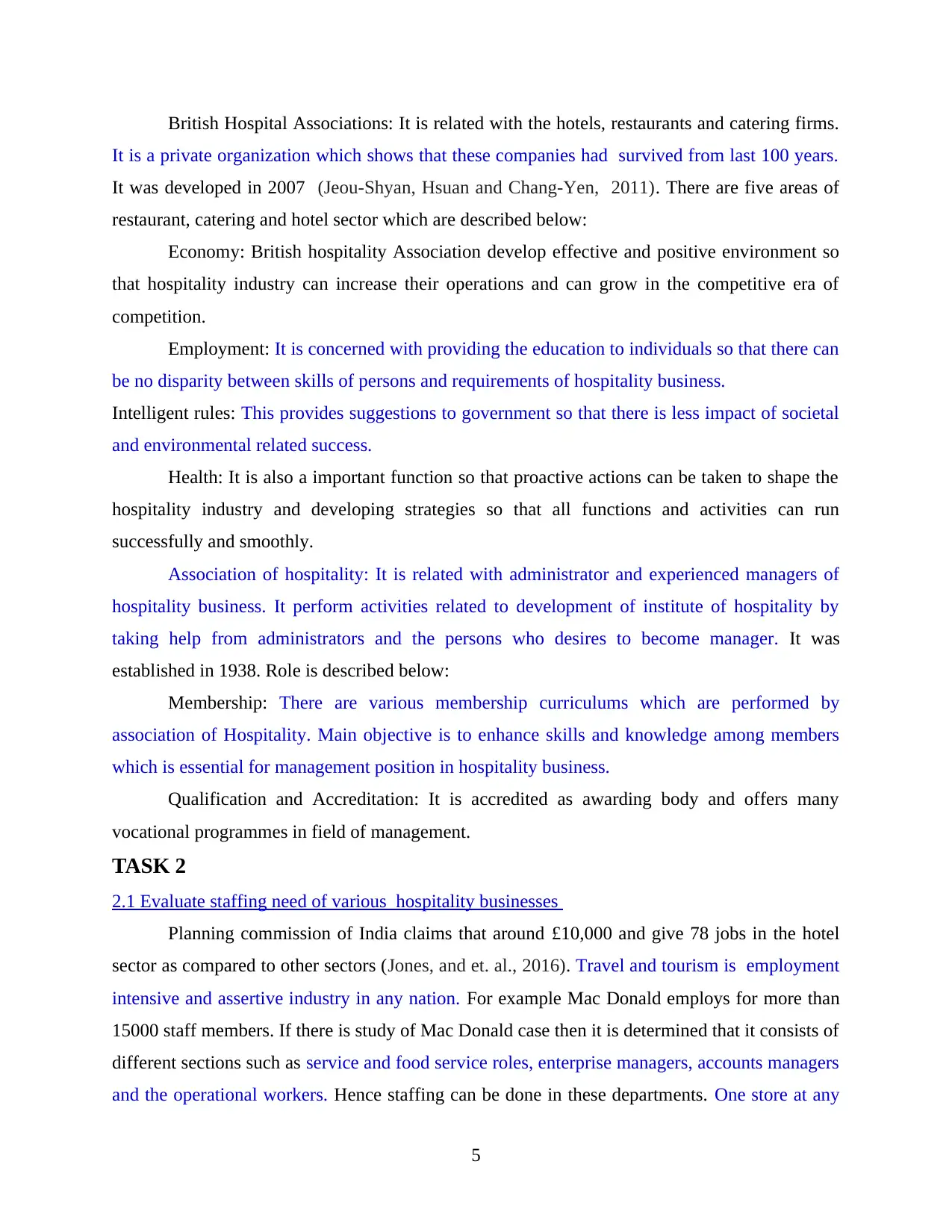
British Hospital Associations: It is related with the hotels, restaurants and catering firms.
It is a private organization which shows that these companies had survived from last 100 years.
It was developed in 2007 (Jeou-Shyan, Hsuan and Chang-Yen, 2011). There are five areas of
restaurant, catering and hotel sector which are described below:
Economy: British hospitality Association develop effective and positive environment so
that hospitality industry can increase their operations and can grow in the competitive era of
competition.
Employment: It is concerned with providing the education to individuals so that there can
be no disparity between skills of persons and requirements of hospitality business.
Intelligent rules: This provides suggestions to government so that there is less impact of societal
and environmental related success.
Health: It is also a important function so that proactive actions can be taken to shape the
hospitality industry and developing strategies so that all functions and activities can run
successfully and smoothly.
Association of hospitality: It is related with administrator and experienced managers of
hospitality business. It perform activities related to development of institute of hospitality by
taking help from administrators and the persons who desires to become manager. It was
established in 1938. Role is described below:
Membership: There are various membership curriculums which are performed by
association of Hospitality. Main objective is to enhance skills and knowledge among members
which is essential for management position in hospitality business.
Qualification and Accreditation: It is accredited as awarding body and offers many
vocational programmes in field of management.
TASK 2
2.1 Evaluate staffing need of various hospitality businesses
Planning commission of India claims that around £10,000 and give 78 jobs in the hotel
sector as compared to other sectors (Jones, and et. al., 2016). Travel and tourism is employment
intensive and assertive industry in any nation. For example Mac Donald employs for more than
15000 staff members. If there is study of Mac Donald case then it is determined that it consists of
different sections such as service and food service roles, enterprise managers, accounts managers
and the operational workers. Hence staffing can be done in these departments. One store at any
5
It is a private organization which shows that these companies had survived from last 100 years.
It was developed in 2007 (Jeou-Shyan, Hsuan and Chang-Yen, 2011). There are five areas of
restaurant, catering and hotel sector which are described below:
Economy: British hospitality Association develop effective and positive environment so
that hospitality industry can increase their operations and can grow in the competitive era of
competition.
Employment: It is concerned with providing the education to individuals so that there can
be no disparity between skills of persons and requirements of hospitality business.
Intelligent rules: This provides suggestions to government so that there is less impact of societal
and environmental related success.
Health: It is also a important function so that proactive actions can be taken to shape the
hospitality industry and developing strategies so that all functions and activities can run
successfully and smoothly.
Association of hospitality: It is related with administrator and experienced managers of
hospitality business. It perform activities related to development of institute of hospitality by
taking help from administrators and the persons who desires to become manager. It was
established in 1938. Role is described below:
Membership: There are various membership curriculums which are performed by
association of Hospitality. Main objective is to enhance skills and knowledge among members
which is essential for management position in hospitality business.
Qualification and Accreditation: It is accredited as awarding body and offers many
vocational programmes in field of management.
TASK 2
2.1 Evaluate staffing need of various hospitality businesses
Planning commission of India claims that around £10,000 and give 78 jobs in the hotel
sector as compared to other sectors (Jones, and et. al., 2016). Travel and tourism is employment
intensive and assertive industry in any nation. For example Mac Donald employs for more than
15000 staff members. If there is study of Mac Donald case then it is determined that it consists of
different sections such as service and food service roles, enterprise managers, accounts managers
and the operational workers. Hence staffing can be done in these departments. One store at any
5
Paraphrase This Document
Need a fresh take? Get an instant paraphrase of this document with our AI Paraphraser
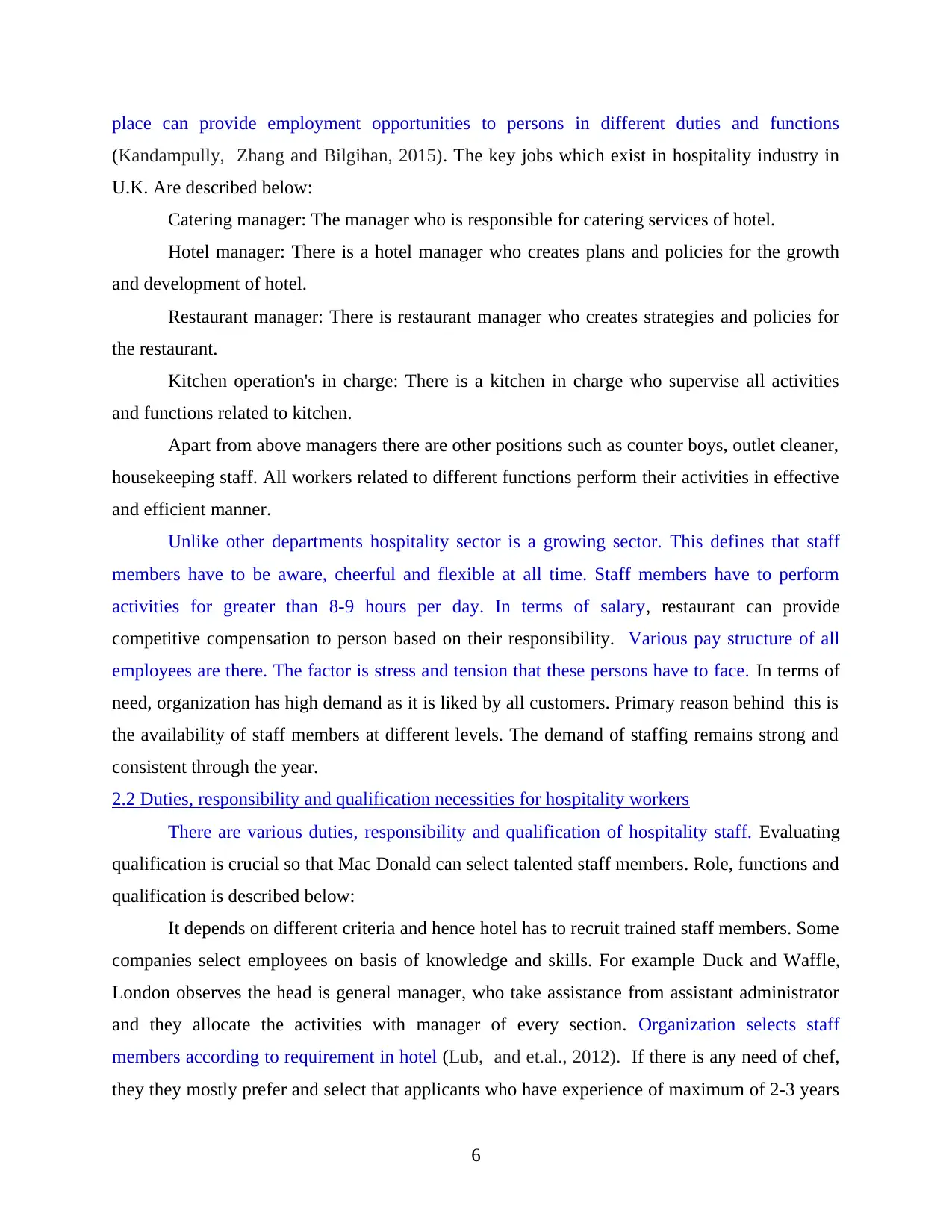
place can provide employment opportunities to persons in different duties and functions
(Kandampully, Zhang and Bilgihan, 2015). The key jobs which exist in hospitality industry in
U.K. Are described below:
Catering manager: The manager who is responsible for catering services of hotel.
Hotel manager: There is a hotel manager who creates plans and policies for the growth
and development of hotel.
Restaurant manager: There is restaurant manager who creates strategies and policies for
the restaurant.
Kitchen operation's in charge: There is a kitchen in charge who supervise all activities
and functions related to kitchen.
Apart from above managers there are other positions such as counter boys, outlet cleaner,
housekeeping staff. All workers related to different functions perform their activities in effective
and efficient manner.
Unlike other departments hospitality sector is a growing sector. This defines that staff
members have to be aware, cheerful and flexible at all time. Staff members have to perform
activities for greater than 8-9 hours per day. In terms of salary, restaurant can provide
competitive compensation to person based on their responsibility. Various pay structure of all
employees are there. The factor is stress and tension that these persons have to face. In terms of
need, organization has high demand as it is liked by all customers. Primary reason behind this is
the availability of staff members at different levels. The demand of staffing remains strong and
consistent through the year.
2.2 Duties, responsibility and qualification necessities for hospitality workers
There are various duties, responsibility and qualification of hospitality staff. Evaluating
qualification is crucial so that Mac Donald can select talented staff members. Role, functions and
qualification is described below:
It depends on different criteria and hence hotel has to recruit trained staff members. Some
companies select employees on basis of knowledge and skills. For example Duck and Waffle,
London observes the head is general manager, who take assistance from assistant administrator
and they allocate the activities with manager of every section. Organization selects staff
members according to requirement in hotel (Lub, and et.al., 2012). If there is any need of chef,
they they mostly prefer and select that applicants who have experience of maximum of 2-3 years
6
(Kandampully, Zhang and Bilgihan, 2015). The key jobs which exist in hospitality industry in
U.K. Are described below:
Catering manager: The manager who is responsible for catering services of hotel.
Hotel manager: There is a hotel manager who creates plans and policies for the growth
and development of hotel.
Restaurant manager: There is restaurant manager who creates strategies and policies for
the restaurant.
Kitchen operation's in charge: There is a kitchen in charge who supervise all activities
and functions related to kitchen.
Apart from above managers there are other positions such as counter boys, outlet cleaner,
housekeeping staff. All workers related to different functions perform their activities in effective
and efficient manner.
Unlike other departments hospitality sector is a growing sector. This defines that staff
members have to be aware, cheerful and flexible at all time. Staff members have to perform
activities for greater than 8-9 hours per day. In terms of salary, restaurant can provide
competitive compensation to person based on their responsibility. Various pay structure of all
employees are there. The factor is stress and tension that these persons have to face. In terms of
need, organization has high demand as it is liked by all customers. Primary reason behind this is
the availability of staff members at different levels. The demand of staffing remains strong and
consistent through the year.
2.2 Duties, responsibility and qualification necessities for hospitality workers
There are various duties, responsibility and qualification of hospitality staff. Evaluating
qualification is crucial so that Mac Donald can select talented staff members. Role, functions and
qualification is described below:
It depends on different criteria and hence hotel has to recruit trained staff members. Some
companies select employees on basis of knowledge and skills. For example Duck and Waffle,
London observes the head is general manager, who take assistance from assistant administrator
and they allocate the activities with manager of every section. Organization selects staff
members according to requirement in hotel (Lub, and et.al., 2012). If there is any need of chef,
they they mostly prefer and select that applicants who have experience of maximum of 2-3 years
6
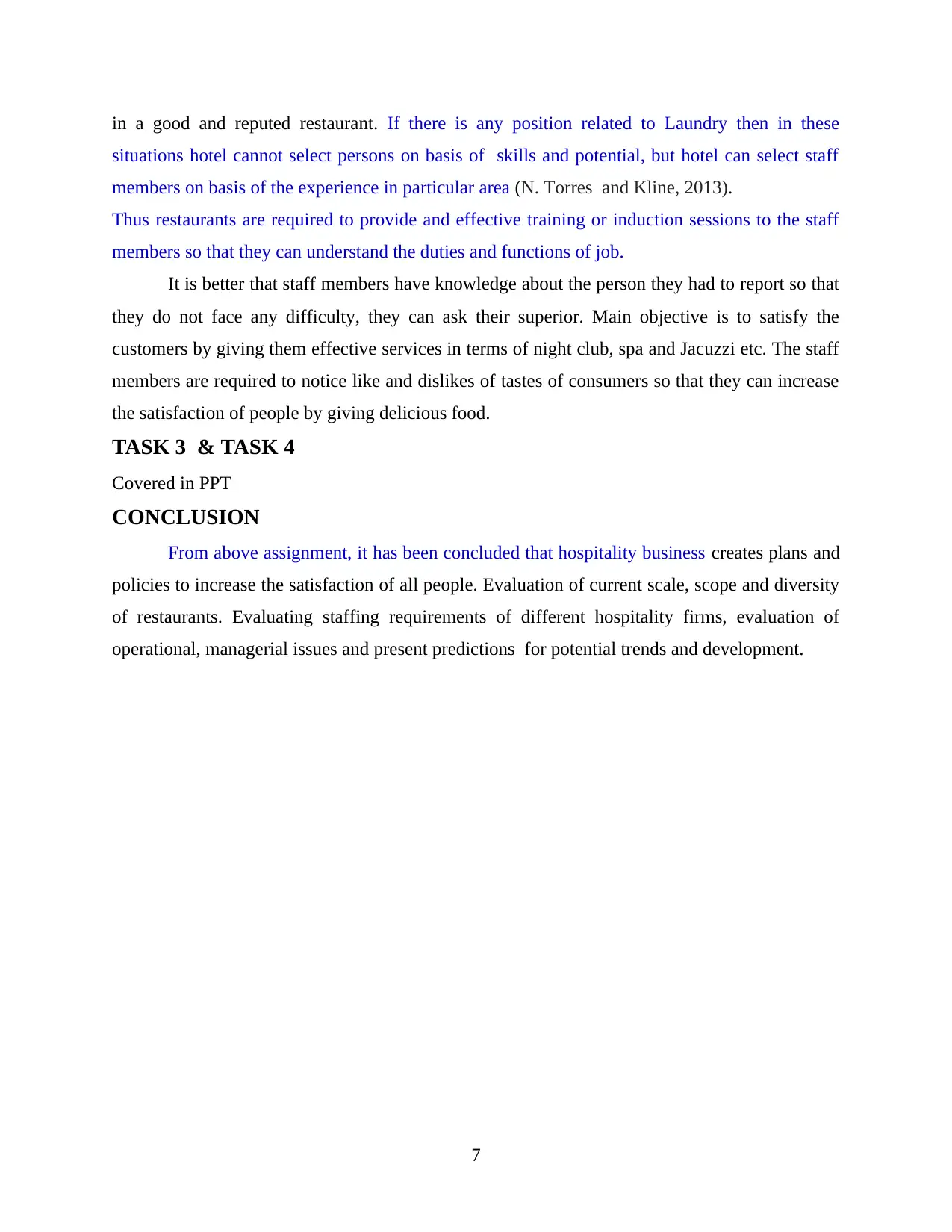
in a good and reputed restaurant. If there is any position related to Laundry then in these
situations hotel cannot select persons on basis of skills and potential, but hotel can select staff
members on basis of the experience in particular area (N. Torres and Kline, 2013).
Thus restaurants are required to provide and effective training or induction sessions to the staff
members so that they can understand the duties and functions of job.
It is better that staff members have knowledge about the person they had to report so that
they do not face any difficulty, they can ask their superior. Main objective is to satisfy the
customers by giving them effective services in terms of night club, spa and Jacuzzi etc. The staff
members are required to notice like and dislikes of tastes of consumers so that they can increase
the satisfaction of people by giving delicious food.
TASK 3 & TASK 4
Covered in PPT
CONCLUSION
From above assignment, it has been concluded that hospitality business creates plans and
policies to increase the satisfaction of all people. Evaluation of current scale, scope and diversity
of restaurants. Evaluating staffing requirements of different hospitality firms, evaluation of
operational, managerial issues and present predictions for potential trends and development.
7
situations hotel cannot select persons on basis of skills and potential, but hotel can select staff
members on basis of the experience in particular area (N. Torres and Kline, 2013).
Thus restaurants are required to provide and effective training or induction sessions to the staff
members so that they can understand the duties and functions of job.
It is better that staff members have knowledge about the person they had to report so that
they do not face any difficulty, they can ask their superior. Main objective is to satisfy the
customers by giving them effective services in terms of night club, spa and Jacuzzi etc. The staff
members are required to notice like and dislikes of tastes of consumers so that they can increase
the satisfaction of people by giving delicious food.
TASK 3 & TASK 4
Covered in PPT
CONCLUSION
From above assignment, it has been concluded that hospitality business creates plans and
policies to increase the satisfaction of all people. Evaluation of current scale, scope and diversity
of restaurants. Evaluating staffing requirements of different hospitality firms, evaluation of
operational, managerial issues and present predictions for potential trends and development.
7
⊘ This is a preview!⊘
Do you want full access?
Subscribe today to unlock all pages.

Trusted by 1+ million students worldwide
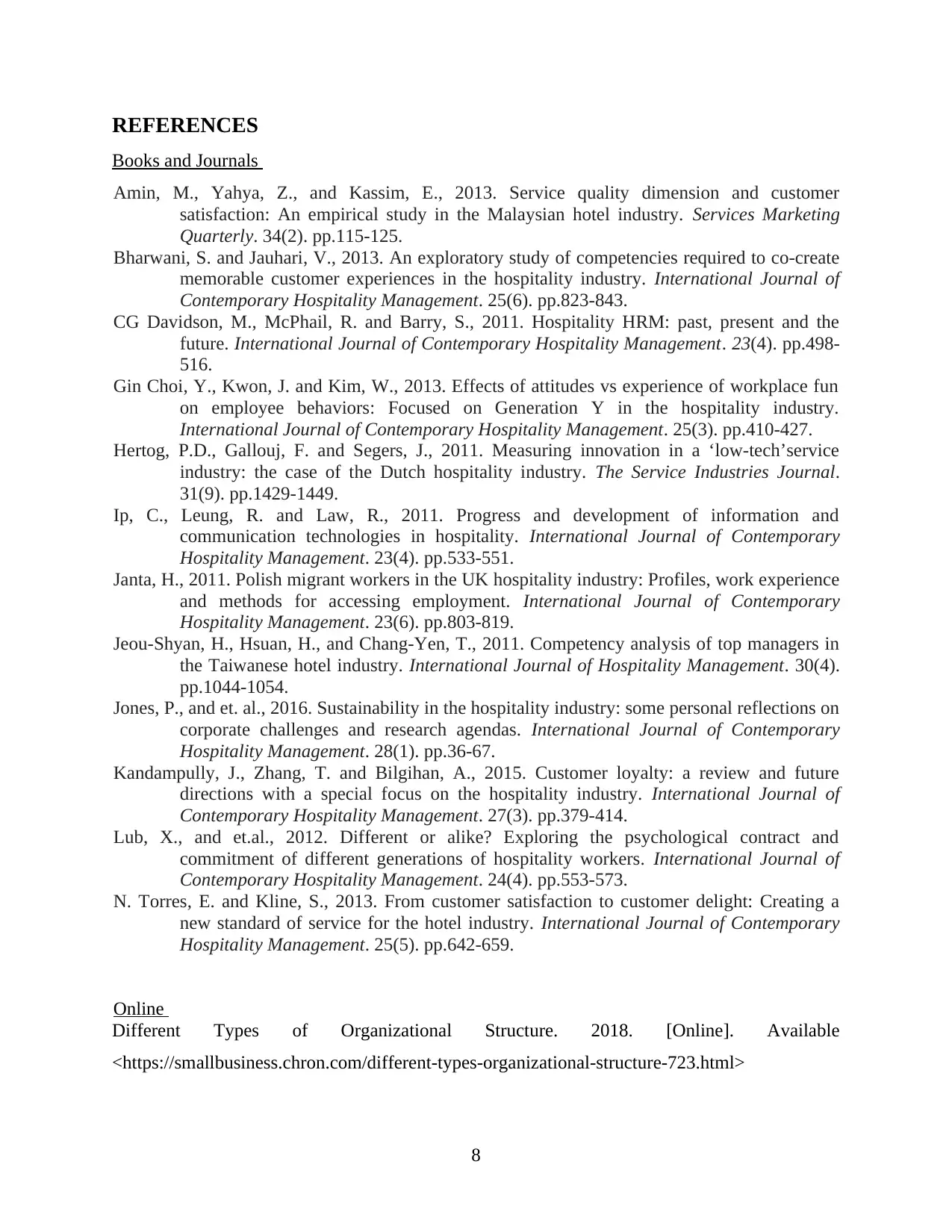
REFERENCES
Books and Journals
Amin, M., Yahya, Z., and Kassim, E., 2013. Service quality dimension and customer
satisfaction: An empirical study in the Malaysian hotel industry. Services Marketing
Quarterly. 34(2). pp.115-125.
Bharwani, S. and Jauhari, V., 2013. An exploratory study of competencies required to co-create
memorable customer experiences in the hospitality industry. International Journal of
Contemporary Hospitality Management. 25(6). pp.823-843.
CG Davidson, M., McPhail, R. and Barry, S., 2011. Hospitality HRM: past, present and the
future. International Journal of Contemporary Hospitality Management. 23(4). pp.498-
516.
Gin Choi, Y., Kwon, J. and Kim, W., 2013. Effects of attitudes vs experience of workplace fun
on employee behaviors: Focused on Generation Y in the hospitality industry.
International Journal of Contemporary Hospitality Management. 25(3). pp.410-427.
Hertog, P.D., Gallouj, F. and Segers, J., 2011. Measuring innovation in a ‘low-tech’service
industry: the case of the Dutch hospitality industry. The Service Industries Journal.
31(9). pp.1429-1449.
Ip, C., Leung, R. and Law, R., 2011. Progress and development of information and
communication technologies in hospitality. International Journal of Contemporary
Hospitality Management. 23(4). pp.533-551.
Janta, H., 2011. Polish migrant workers in the UK hospitality industry: Profiles, work experience
and methods for accessing employment. International Journal of Contemporary
Hospitality Management. 23(6). pp.803-819.
Jeou-Shyan, H., Hsuan, H., and Chang-Yen, T., 2011. Competency analysis of top managers in
the Taiwanese hotel industry. International Journal of Hospitality Management. 30(4).
pp.1044-1054.
Jones, P., and et. al., 2016. Sustainability in the hospitality industry: some personal reflections on
corporate challenges and research agendas. International Journal of Contemporary
Hospitality Management. 28(1). pp.36-67.
Kandampully, J., Zhang, T. and Bilgihan, A., 2015. Customer loyalty: a review and future
directions with a special focus on the hospitality industry. International Journal of
Contemporary Hospitality Management. 27(3). pp.379-414.
Lub, X., and et.al., 2012. Different or alike? Exploring the psychological contract and
commitment of different generations of hospitality workers. International Journal of
Contemporary Hospitality Management. 24(4). pp.553-573.
N. Torres, E. and Kline, S., 2013. From customer satisfaction to customer delight: Creating a
new standard of service for the hotel industry. International Journal of Contemporary
Hospitality Management. 25(5). pp.642-659.
Online
Different Types of Organizational Structure. 2018. [Online]. Available
<https://smallbusiness.chron.com/different-types-organizational-structure-723.html>
8
Books and Journals
Amin, M., Yahya, Z., and Kassim, E., 2013. Service quality dimension and customer
satisfaction: An empirical study in the Malaysian hotel industry. Services Marketing
Quarterly. 34(2). pp.115-125.
Bharwani, S. and Jauhari, V., 2013. An exploratory study of competencies required to co-create
memorable customer experiences in the hospitality industry. International Journal of
Contemporary Hospitality Management. 25(6). pp.823-843.
CG Davidson, M., McPhail, R. and Barry, S., 2011. Hospitality HRM: past, present and the
future. International Journal of Contemporary Hospitality Management. 23(4). pp.498-
516.
Gin Choi, Y., Kwon, J. and Kim, W., 2013. Effects of attitudes vs experience of workplace fun
on employee behaviors: Focused on Generation Y in the hospitality industry.
International Journal of Contemporary Hospitality Management. 25(3). pp.410-427.
Hertog, P.D., Gallouj, F. and Segers, J., 2011. Measuring innovation in a ‘low-tech’service
industry: the case of the Dutch hospitality industry. The Service Industries Journal.
31(9). pp.1429-1449.
Ip, C., Leung, R. and Law, R., 2011. Progress and development of information and
communication technologies in hospitality. International Journal of Contemporary
Hospitality Management. 23(4). pp.533-551.
Janta, H., 2011. Polish migrant workers in the UK hospitality industry: Profiles, work experience
and methods for accessing employment. International Journal of Contemporary
Hospitality Management. 23(6). pp.803-819.
Jeou-Shyan, H., Hsuan, H., and Chang-Yen, T., 2011. Competency analysis of top managers in
the Taiwanese hotel industry. International Journal of Hospitality Management. 30(4).
pp.1044-1054.
Jones, P., and et. al., 2016. Sustainability in the hospitality industry: some personal reflections on
corporate challenges and research agendas. International Journal of Contemporary
Hospitality Management. 28(1). pp.36-67.
Kandampully, J., Zhang, T. and Bilgihan, A., 2015. Customer loyalty: a review and future
directions with a special focus on the hospitality industry. International Journal of
Contemporary Hospitality Management. 27(3). pp.379-414.
Lub, X., and et.al., 2012. Different or alike? Exploring the psychological contract and
commitment of different generations of hospitality workers. International Journal of
Contemporary Hospitality Management. 24(4). pp.553-573.
N. Torres, E. and Kline, S., 2013. From customer satisfaction to customer delight: Creating a
new standard of service for the hotel industry. International Journal of Contemporary
Hospitality Management. 25(5). pp.642-659.
Online
Different Types of Organizational Structure. 2018. [Online]. Available
<https://smallbusiness.chron.com/different-types-organizational-structure-723.html>
8
1 out of 10
Related Documents
Your All-in-One AI-Powered Toolkit for Academic Success.
+13062052269
info@desklib.com
Available 24*7 on WhatsApp / Email
![[object Object]](/_next/static/media/star-bottom.7253800d.svg)
Unlock your academic potential
Copyright © 2020–2025 A2Z Services. All Rights Reserved. Developed and managed by ZUCOL.





